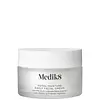What's inside
What's inside
 Key Ingredients
Key Ingredients

 Benefits
Benefits

 Concerns
Concerns

 Ingredients Side-by-side
Ingredients Side-by-side

Water
Skin ConditioningGlycerin
HumectantDimethicone
EmollientSqualane
EmollientCaprylic/Capric Triglyceride
MaskingBis-PEG-18 Methyl Ether Dimethyl Silane
EmollientPentaerythrityl Tetraethylhexanoate
EmollientPropanediol
SolventArachidyl Alcohol
EmollientCetearyl Alcohol
EmollientInulin
Skin ConditioningBehenyl Alcohol
EmollientPhenoxyethanol
PreservativeArachidyl Glucoside
EmulsifyingTocopheryl Acetate
AntioxidantCaprylyl Glycol
EmollientLinoleic Acid
CleansingSaccharomyces Ferment Filtrate
HumectantGlyceryl Glucoside
HumectantSodium Hyaluronate
HumectantAcetyl Heptapeptide-4
HumectantLinolenic Acid
CleansingCetearyl Glucoside
EmulsifyingSodium Polyacryloyldimethyl Taurate
Emulsion StabilisingDiglycerin
HumectantCeramide NP
Skin ConditioningSodium PCA
HumectantUrea
BufferingCarbomer
Emulsion StabilisingDisodium EDTA
Hydrogenated Polydecene
EmollientEthylhexylglycerin
Skin ConditioningXanthan Gum
EmulsifyingAcrylates/C10-30 Alkyl Acrylate Crosspolymer
Emulsion StabilisingSodium Hydroxide
BufferingLactic Acid
BufferingLysine
Skin ConditioningPCA
HumectantSorbitol
HumectantButylene Glycol
Humectant1,2-Hexanediol
Skin ConditioningTrideceth-10
CleansingTocopherol
AntioxidantHydrolyzed Wheat Protein
Skin ConditioningAllantoin
Skin ConditioningOryza Sativa Lees Extract
Skin ConditioningWater, Glycerin, Dimethicone, Squalane, Caprylic/Capric Triglyceride, Bis-PEG-18 Methyl Ether Dimethyl Silane, Pentaerythrityl Tetraethylhexanoate, Propanediol, Arachidyl Alcohol, Cetearyl Alcohol, Inulin, Behenyl Alcohol, Phenoxyethanol, Arachidyl Glucoside, Tocopheryl Acetate, Caprylyl Glycol, Linoleic Acid, Saccharomyces Ferment Filtrate, Glyceryl Glucoside, Sodium Hyaluronate, Acetyl Heptapeptide-4, Linolenic Acid, Cetearyl Glucoside, Sodium Polyacryloyldimethyl Taurate, Diglycerin, Ceramide NP, Sodium PCA, Urea, Carbomer, Disodium EDTA, Hydrogenated Polydecene, Ethylhexylglycerin, Xanthan Gum, Acrylates/C10-30 Alkyl Acrylate Crosspolymer, Sodium Hydroxide, Lactic Acid, Lysine, PCA, Sorbitol, Butylene Glycol, 1,2-Hexanediol, Trideceth-10, Tocopherol, Hydrolyzed Wheat Protein, Allantoin, Oryza Sativa Lees Extract
Water
Skin ConditioningCoco-Caprylate/Caprate
EmollientCaprylic/Capric Triglyceride
MaskingC10-18 Triglycerides
EmollientSmithsonite Extract
AntioxidantGlycerin
HumectantC12-16 Alcohols
EmollientMethylpropanediol
SolventHydrogenated Lecithin
EmulsifyingPalmitic Acid
EmollientCetyl Alcohol
EmollientGlyceryl Stearate Citrate
EmollientTapioca Starch
Secale Cereale Seed Extract
AbrasivePaeonia Albiflora Root Extract
Skin ConditioningHelichrysum Stoechas Extract
TonicHelianthus Annuus Seed Oil
EmollientPlantago Lanceolata Seed Extract
Skin ConditioningLycium Barbarum Callus Culture Extract
Skin ConditioningAlteromonas Ferment Extract
Skin ConditioningDiaminopropionoyl Tripeptide-33
Skin ConditioningMaltodextrin
AbsorbentTocopherol
AntioxidantLecithin
EmollientIsomalt
Humectant1,2-Hexanediol
Skin ConditioningSorbitan Isostearate
EmulsifyingHydroxyethyl Acrylate/Sodium Acryloyldimethyl Taurate Copolymer
Emulsion StabilisingPolysorbate 60
EmulsifyingCaprylyl Glycol
EmollientPhenylpropanol
MaskingPhenethyl Alcohol
MaskingWater, Coco-Caprylate/Caprate, Caprylic/Capric Triglyceride, C10-18 Triglycerides, Smithsonite Extract, Glycerin, C12-16 Alcohols, Methylpropanediol, Hydrogenated Lecithin, Palmitic Acid, Cetyl Alcohol, Glyceryl Stearate Citrate, Tapioca Starch, Secale Cereale Seed Extract, Paeonia Albiflora Root Extract, Helichrysum Stoechas Extract, Helianthus Annuus Seed Oil, Plantago Lanceolata Seed Extract, Lycium Barbarum Callus Culture Extract, Alteromonas Ferment Extract, Diaminopropionoyl Tripeptide-33, Maltodextrin, Tocopherol, Lecithin, Isomalt, 1,2-Hexanediol, Sorbitan Isostearate, Hydroxyethyl Acrylate/Sodium Acryloyldimethyl Taurate Copolymer, Polysorbate 60, Caprylyl Glycol, Phenylpropanol, Phenethyl Alcohol
 Reviews
Reviews

Ingredients Explained
These ingredients are found in both products.
Ingredients higher up in an ingredient list are typically present in a larger amount.
1,2-Hexanediol is a synthetic liquid and another multi-functional powerhouse.
It is a:
- Humectant, drawing moisture into the skin
- Emollient, helping to soften skin
- Solvent, dispersing and stabilizing formulas
- Preservative booster, enhancing the antimicrobial activity of other preservatives
This ingredient is an emollient, solvent, and texture enhancer. It is considered a skin-softener by helping the skin prevent moisture loss.
It helps thicken a product's formula and makes it easier to spread by dissolving clumping compounds.
Caprylic Triglyceride is made by combining glycerin with coconut oil, forming a clear liquid.
While there is an assumption Caprylic Triglyceride can clog pores due to it being derived from coconut oil, there is no research supporting this.
Learn more about Caprylic/Capric TriglycerideCaprylyl Glycol is a humectant and emollient, meaning it attracts and preserves moisture.
It is a common ingredient in many products, especially those designed to hydrate skin. The primary benefits are retaining moisture, skin softening, and promoting a healthy skin barrier.
Though Caprylyl Glycol is an alcohol derived from fatty acids, it is not the kind that can dry out skin.
This ingredient is also used as a preservative to extend the life of products. It has slight antimicrobial properties.
Learn more about Caprylyl GlycolGlycerin is already naturally found in your skin. It helps moisturize and protect your skin.
A study from 2016 found glycerin to be more effective as a humectant than AHAs and hyaluronic acid.
As a humectant, it helps the skin stay hydrated by pulling moisture to your skin. The low molecular weight of glycerin allows it to pull moisture into the deeper layers of your skin.
Hydrated skin improves your skin barrier; Your skin barrier helps protect against irritants and bacteria.
Glycerin has also been found to have antimicrobial and antiviral properties. Due to these properties, glycerin is often used in wound and burn treatments.
In cosmetics, glycerin is usually derived from plants such as soybean or palm. However, it can also be sourced from animals, such as tallow or animal fat.
This ingredient is organic, colorless, odorless, and non-toxic.
Glycerin is the name for this ingredient in American English. British English uses Glycerol/Glycerine.
Learn more about GlycerinTocopherol (also known as Vitamin E) is a common antioxidant used to help protect the skin from free-radicals and strengthen the skin barrier. It's also fat soluble - this means our skin is great at absorbing it.
Vitamin E also helps keep your natural skin lipids healthy. Your lipid skin barrier naturally consists of lipids, ceramides, and fatty acids. Vitamin E offers extra protection for your skin’s lipid barrier, keeping your skin healthy and nourished.
Another benefit is a bit of UV protection. Vitamin E helps reduce the damage caused by UVB rays. (It should not replace your sunscreen). Combining it with Vitamin C can decrease sunburned cells and hyperpigmentation after UV exposure.
You might have noticed Vitamin E + C often paired together. This is because it is great at stabilizing Vitamin C. Using the two together helps increase the effectiveness of both ingredients.
There are often claims that Vitamin E can reduce/prevent scarring, but these claims haven't been confirmed by scientific research.
Learn more about TocopherolWater. It's the most common cosmetic ingredient of all. You'll usually see it at the top of ingredient lists, meaning that it makes up the largest part of the product.
So why is it so popular? Water most often acts as a solvent - this means that it helps dissolve other ingredients into the formulation.
You'll also recognize water as that liquid we all need to stay alive. If you see this, drink a glass of water. Stay hydrated!
Learn more about Water